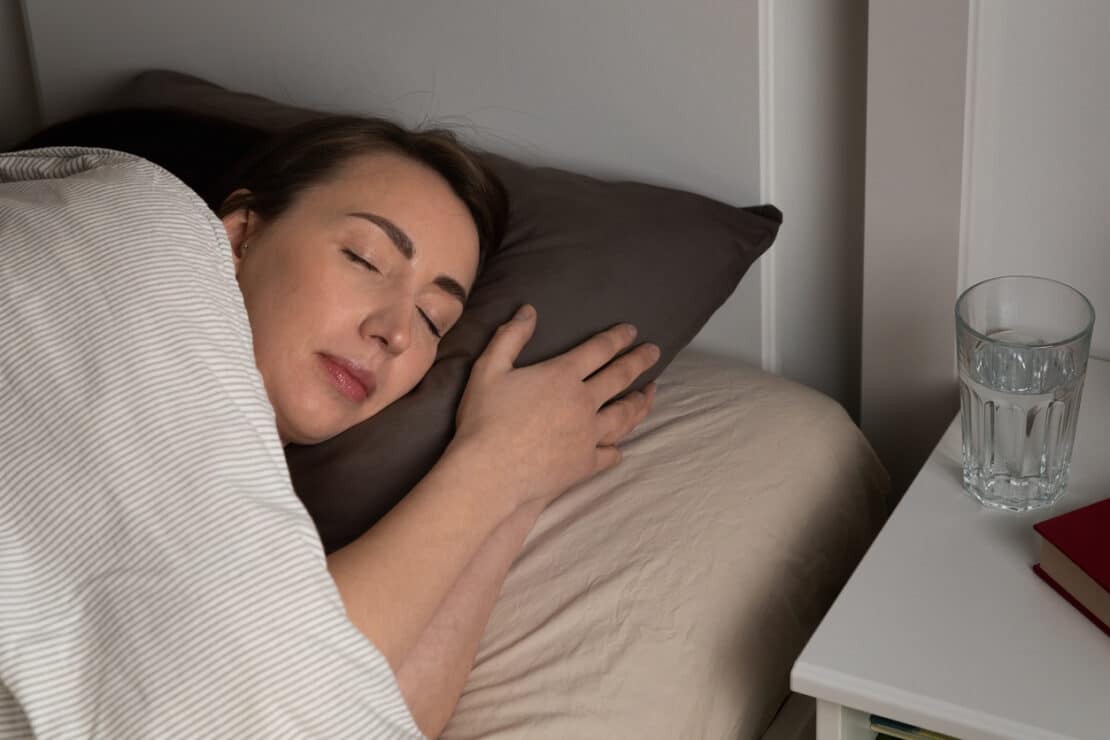A new study shows that one easy diet change can end annoying nighttime bathroom trips.
After age 50, most people wake up one or more times a night to urinate. This is a condition called nocturia. It can lead to sleep disruption, daytime tiredness, irritability, and stress.[1]
Most people with this problem are told to reduce the amount of water they drink before bedtime. But drinking plenty of water is important to good health. Going without water before you go to bed may even be unsafe.
That’s because while you sleep, your body loses water. It evaporates through your skin and your exhaling breaths. You lose up to 32 ounces every night.[2]
Why You Shouldn’t Go to Bed Thirsty
If you go without water before bed, you may become dehydrated. When that happens, the volume of your blood and blood pressure drop.
To maintain blood pressure, your body constricts blood vessels and increases your heart rate. Your heart has to work extra hard to force blood through your narrowed blood vessels. A major study found that the stress dehydration puts on your heart can lead to a heart attack.[3]
There’s a better, safer way than going thirsty to avoid bathroom runs…
Scientists at Nagasaki University in Japan gathered over 300 adults at least 45 years of age. They all had nocturia.
The subjects were divided into two groups. One group reduced their salt intake from 11 grams to 8 grams a day. The other group consumed 11 grams of salt every day.
Eleven grams of salt contains about 4,400 mg of sodium. Eight grams of salt has about 3,200 mg of sodium.[4]
The reduced-salt group cut their number of nighttime bathroom trips almost in half. After 12 weeks, they went from an average of 2.3 trips a night to 1.4.
Meanwhile, the control group needed to use the bathroom more frequently. They went from 2.3 bathroom visits a night to 2.7.[5]
Dr. Tomohiro Matsuo is a urology professor at Nagasaki University. He led the research. “This simple dietary modification might significantly improve the quality of life for many people,” he said.
The study “is the first study to measure how salt intake affects the frequency of going to the bathroom,” said Dr. Matsuo. It was presented at the European Society of Urology annual meeting.[6]
6 Sneaky Sources of Salt in Your Diet
To reduce bathroom trips, you don’t have to go thirsty. Nor do you have to deprive yourself of salt. The 3,200 mg of sodium used in the study is far from a “low-salt diet.” Most of those allow only about 1,500 mg.[7]
You likely get sodium in foods that you would never think of as salty. Reduce them and you automatically get less sodium.
Here’s where salt is hiding in your diet:
Condiments. Ketchup, commercial mustards, barbeque sauce, steak sauce, anything pickled, and store-bought dips are all loaded with salt.
Cheeses. Lots of salt is used in cheese making. The worst offenders are blue, gorgonzola, and Roquefort cheeses.
Canned soups, stews, vegetables. Some soups contain over 2.5 grams of salt (1,000 mg of sodium) per serving. Canned beef stew and chili are often even higher. Canned vegetables not only are filled with sodium, they have far lower nutrient levels than fresh.
Baked goods. Whether sweet or savory, commercial baked goods are full of salt.
Cured, smoked, or processed meats. A single strip of bacon has over 1.5 grams of salt (620 mg of sodium). Processed meats are among the worst things you can eat.
Fast food. You don’t need us to tell you that you should drop fast food from your diet. It’s bad for your heart, brain, liver, and just about everything else. Americans get 75% of their salt from processed and fast foods. That fast food burger or chicken sandwich can contain 3.5 grams of salt (1,450 mg of sodium).[8] [9]
One other thing…
Replace the industrial table salt in your shaker with natural sea salt.
Table salt has all the nutrients stripped out of it. All that’s left is sodium and chloride…with some chemical additives thrown in. Sea salt contains dozens of essential minerals. And it tends to be more flavorful. So you’ll use less.[10]
Editor’s Note: Discover natural, non-drug methods to transform your health. Read our monthly journal, Independent Healing. It’s your best source for unbiased, evidence-based medical information. For more information, click HERE.
Related Articles
Nighttime Bathroom Trips Are a Sign of This Serious Health Condition
What’s More Annoying Than Nighttime Bathroom Trips? A Heart Attack
5 Best Replacements for Table Salt (They Taste Better Too)
References
[1] http://www.bbc.com/news/health-39382339
[2] https://www.washingtoncitypaper.com/columns/straight-dope/article/13040026/straight-dope-do-you-really-sweat-one-liter-each-night
[3] https://academic.oup.com/aje/article/155/9/827/58224
[4] http://foodwatch.com.au/blog/measures-and-conversions/item/how-to-convert-sodium-to-salt-and-salt-to-sodium.html
[5] https://consumer.healthday.com/diseases-and-conditions-information-37/urine-problems-news-687/less-salt-fewer-nighttime-bathroom-trips-720959.html
[6] https://consumer.healthday.com/diseases-and-conditions-information-37/urine-problems-news-687/less-salt-fewer-nighttime-bathroom-trips-720959.html
[7] http://www.dashdietoregon.org/why/The-Lowdown-on-Sodium
[8] https://www.caring.com/articles/top-10-hidden-sources-of-salt
[9] http://www.fda.gov/forconsumers/consumerupdates/ucm181577.htm
[10] https://www.institutefornaturalhealing.com/2015/02/5-best-replacements-for-table-salt-they-taste-better-too/

